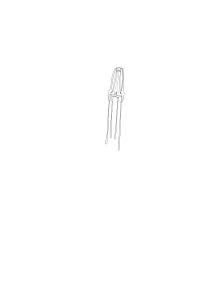Alatina alata
| Alatina alata | |
|---|---|
 | |
| Alatina alata | |
| Scientific classification | |
| Kingdom: | Animalia |
| Phylum: | Cnidaria |
| Class: | Cubozoa |
| Order: | Carybdeida |
| Family: | Alatinidae |
| Genus: | Alatina |
| Species: | A. alata |
| Binomial name | |
| Alatina alata (Reynaud), 1830[1] | |
| Synonyms | |
|
Carybdea alata | |
Alatina alata is a Pacific and Atlantic Ocean species of box jellyfish, often referred to as a sea wasp.
Description
Alatina alata is a transparent box jellyfish with a bell height of 9 inches (230 mm). The species may lack nematocyst warts at least when young. The bell itself is transparent and very hyaline (glassy). Species of the Pacific (not including areas near Hawaii) are often very large, up to 12 inches (300 mm) long and up to 6 inches (150 mm) wide. Atlantic specimens vary in size from 5 inches (130 mm) long and 2 inches (51 mm) wide up to 10 inches (250 mm) long and 5 inches (130 mm) wide, occasionally larger. Some specimens have been seen with nematocyst warts. Alatina alata in Hawaii are about 6 inches (150 mm) long by 3 inches (76 mm) wide on average.
Distribution
Alatina alata ranges across the Pacific and Atlantic and possibly the Indian Ocean. It is also found in the Arabian Sea along the beaches of Pakistan.[3]
Toxicity
Though the sting itself of Alatina alata is not particularly dangerous, it can cause a life-threatening reaction known as irukandji syndrome. Unlike the true irukandji which stings may barely be noticed at first, Alatina alata causes severe pain as soon as you are stung. From 5–120 minutes later the symptoms start. They include: headache, backache, muscle, chest, and abdominal pains, nausea, vomiting, sweating, anxiety, hypertension, tachycardia, and pulmonary edema.
Taxonomy
Known for many years as Carybdea alata, it was given its current binomial name by Lisa-Ann Gershwin in 2005.
The diversity of each species may require more new species such as: Atlantic specimens (2 for with or without nematocyst warts), Indian Ocean species, several Pacific (not including Hawaii species) types, and an individual species for Hawaii
References
- ↑ Alatina alata Reynaud, 1830. Retrieved through: World Register of Marine Species.
- ↑ Carybdea alata Reynaud, 1830 . Retrieved through: World Register of Marine Species.
- ↑ http://www.scribd.com/doc/37674159/Carybdea-marsupialis-JMBE